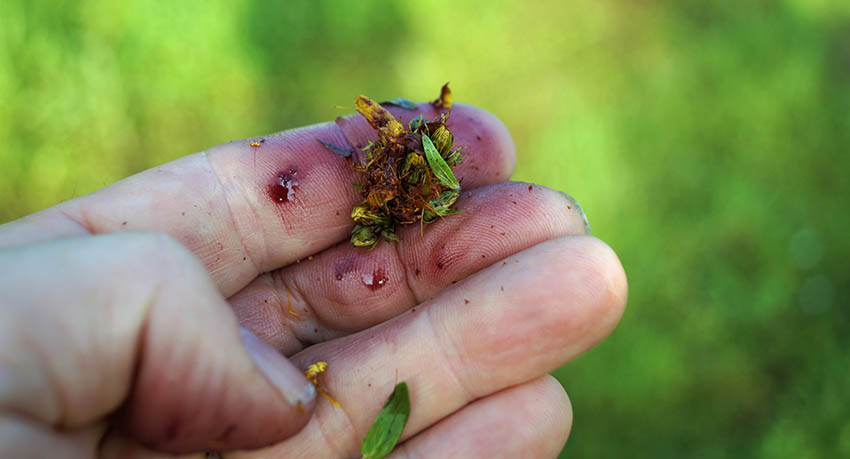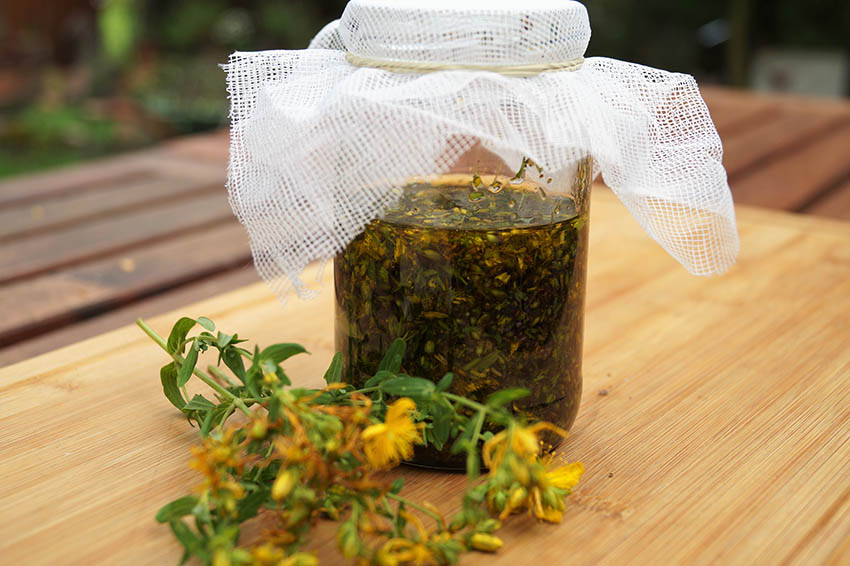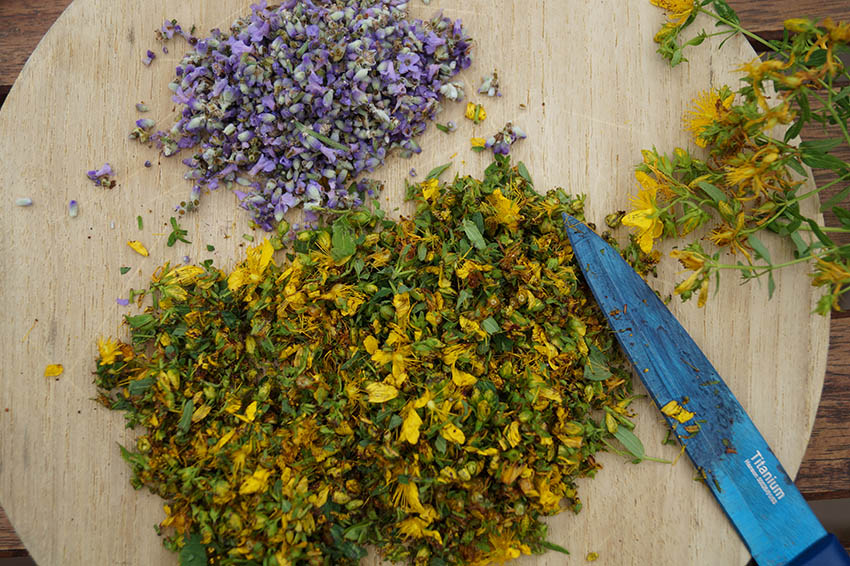Just in time for the summer solstice (June 21) and St. John’s Day (June 24), St. John’s wort (Hypericum perforatum) begins to bloom in many regions. It is a plant that likes to be in full sun and loves the summer heat. With its bright yellow flowers, St. John’s wort seems to literally soak up the sun’s energy. Since ancient times, the flowering herb has been used for medicinal purposes, especially the production of St. John’s wort oil or “red oil” has a long tradition. Read here how to make St. John’s wort oil and what you need to keep in mind.
Contents
- 0.1 Making St. John’s wort: Collecting the right St. John’s wort
- 0.2 Traditionally a valuable medicine: When can St. John’s wort help?
- 0.3 Make St. John’s wort oil: A balm for sore skin
- 0.4 Why too much sun harms St. John’s wort oil?
- 1 Making homemade St. John’s wort oil: Tips and hints
- 2 This is how it works
- 3 Author
Making St. John’s wort: Collecting the right St. John’s wort
There are over 400 species of St. John’s wort worldwide, nine of which are native to Europe. The medicinally used St. John’s wort (Hypericum perforatum) has several distinguishing features that make it possible to distinguish it from other St. John’s herbs: you can recognize it by the leaves that look like “perforated”. The translucent dots, which are easily seen when the leaf is held up to the light, are small glands filled with essential oil. The dark dots in the yellow flowers and buds contain the red-staining hypericin. To sample, rub the flowers between your fingers and they will turn red. Also characteristic of the medicinal plant are the two opposite angular longitudinal ridges of the stem, which can be easily felt with the fingers. Also striking are the somewhat asymmetrically arranged petals, which resemble a pinwheel. If you recognize all these features, then you have found the right St. John’s wort.
Traditionally a valuable medicine: When can St. John’s wort help?
St. John’s wort has become known primarily for its antidepressant, mood-lifting and anxiety-relieving effects. After this effect could be scientifically proven about 30 years ago, the herb became a “shooting star”. It is now one of the best-selling herbal medicines. According to recent research, extracts of St. John’s wort are similarly effective as a synthetic antidepressant in the treatment of moderate depression and, in contrast to the latter, are much better tolerated. However, the necessary high dosage cannot be achieved with a homemade St. John’s wort tea, but only with concentrated ready-made medicines from St. John’s wort. Since these high-dose preparations can also influence the effect of certain medicines, their use should definitely be discussed with a doctor, pharmacist or alternative practitioner.

Make St. John’s wort oil: A balm for sore skin
St. John’s wort has other healing properties that are particularly interesting for external use. It has wound-healing, anti-inflammatory, circulation-promoting, antibacterial and pain-relieving effects.
The wonderful St. John’s wort oil should therefore not be missing in any medicine cabinet. It helps as a rub for joint and muscle pain, as well as for bruises, sprains, dislocations and bruises. The treatment repertoire also includes sunburn, nerve pain, lumbago, bedsores, scars and eczema.

Why too much sun harms St. John’s wort oil?
Recent studies have shown that in the traditional production of St. John’s wort oil in the sun, some mistakes are made that negatively affect the result. For example, in the past, people placed the oil in full sun for four weeks, presumably to include a lunation (from full moon to full moon). Today, it is known that sunlight severely damages the important active ingredient, hyperforin. Hyperforin is mainly responsible for the oil’s antibacterial, anti-inflammatory and wound-healing properties.
But the oil itself also suffers from sunlight. Direct sunlight and contact with oxygen cause decomposition processes to begin very quickly in the oil. The stability of the oil is lost and the shelf life is reduced. Experiments have shown that even the stable olive oil (without herbs added) was already rancid after two to three days. Due to direct sunlight and oxygen contact, decomposition processes start very quickly in the oil.
Incidentally, it is the added St. John’s wort that prevents the oil extract from going rancid prematurely. The medicinal herb offers antioxidant protective substances to the oil. However, the St. John’s wort itself loses its active ingredients due to this protective function. So when we make a St. John’s wort oil, the extracted active ingredients degrade at the same rate as the oil is oxidatively stressed by oxygen, heat and sunlight.
So, as a summary conclusion, long sun extractions (four to six weeks) result in an oil extract with few active ingredients and a short shelf life! Therefore, the oil is in no case longer than three to six days in the sun!
Making homemade St. John’s wort oil: Tips and hints
Making the helpful St. John’s wort oil is not difficult (see recipe). However, you should pay attention to a few things in the process, so that in the end you get a good and long-lasting product.
Tips at harvest time
When preparing the oil, there are a few things you can keep in mind: St. John’s wort should definitely be used fresh, as the important active ingredient hyperforin is lost when it dries. Also, most of the hyperforin is present in the green seedpods, so it’s best to harvest the herb around flowering time, when some of the flowers have already bloomed off. So wait with the oil preparation until the first green seed pods become visible in the month of July.
In general, you should make sure that as many different plant organs as possible are used in the oil, since each part of the plant contains special active ingredients: The leaves provide essential oil, the flowers and buds contain the red pigment hypericin as well as flavonoids, while the green seed capsules contribute the anti-inflammatory hyperforin. So use completely the upper 20 cm of the plant, so that flowers, buds, leaves and green seed capsules come into the oil.
Notes on light exposure when making St. John’s wort oil.
Furthermore, it is important that you protect the oil from direct light irradiation, because light destroys the active ingredient hyperforin. Therefore, an oil extract in amber glass or blue glass makes more sense than in white glass. If you still want to use a white glass container for lack of alternatives, cover it with a thin cotton cloth or place the jar in a warm shady place rather than in direct sunlight.
Interestingly, our ancestors did everything right: they put the St. John’s wort oil in the sun, but in opaque earthenware pots. Moreover, they took not only the flowers, but also the seed pods as described, for example, by the physician Tabernaemontanus in 1588: “Finally, poke the pods together with the seed and put them also in the oil”. And the physician Johann Schröder (1600-1664) said, “Take the upper tips with the flowers when they soon begin to bear seed sheer.”
Shelf life tips: precautions regarding water.
Fresh St. John’s wort has a high water content, which can cause mold and reduce the shelf life of the oil if not handled properly. Therefore, do not wash St. John’s wort under any circumstances, as this will increase the amount of water. This assumes that when you collect it, you make sure to harvest only clean and healthy parts of the plant.
In addition, the extraction vessel is closed in a breathable way (e.g. fly gauze, cotton compress) so that excess water can evaporate. Condensation forms in closed vessels. When filtering the extract oil, the plants are not squeezed under any circumstances, so that the water content in the oil does not become too high. Squeezing is the biggest source of error when making oil macerates from fresh plants. So pour the extract oil into a large fine sieve and let the oil drain for several hours. After that, you can squeeze the St. John’s wort into another container. This quality reduced (because watered down) oil they should then use as soon as possible, because it quickly loses stability.

Making St. John’s wort oil: Recipe for a variant with lavender
St. John’s wort lavender oil has a strong wound-healing and anti-inflammatory effect. It combines the healing power of two great medicinal plants that bloom at the same time in summer and enhance each other’s effects.
Ingredients
- 500 ml olive oil
- 75 g fresh St. John’s wort
- 25 g fresh lavender flowers
- 20 drops of lavender oil
This is how it works
- Place the finely chopped herbs in oil and let them infuse there for 3-6 days in a warm place in a dark container. Temperatures between 30 and 40° C are ideal.
- Stir the oil several times a day during the extraction period, if possible, so that the active ingredients are well transferred into the oil.
- Filter the oil after 3-6 days. Now you can add the lavender essential oil. If possible, fill it into dark bottles (amber glass, violet glass). This way it will keep for about 9 months, after which the hyperforin will rapidly degrade.

St. John’s wort in the Middle Ages: Helpful against witches and thunderstorms
In the Middle Ages, St. John’s wort had not only medicinal uses, but it was also an important plant of the protective spell. Hung on the wall, worn as an amulet or placed under the pillow, it protected against witches, demons and the devil. Even the church persecutors of witches were convinced of its effect. To break the power of the devil, they instilled St. John’s wort tea into their defenseless victims during torture. Until modern times, St. John’s wort preparations were used by the Catholic Church during exorcism to drive out demons.
The power of St. John’s wort against the devil is supported in numerous folk tales. For example, it is told of a young woman who had succumbed to the devil’s seductive powers. One day the devil pursued her in order to get her completely under his control. In her distress, she spotted a blooming “Hartenau” (= St. John’s wort) by the wayside. She quickly sat down on the yellow flower and the devil was powerless. Then he cried angrily, “Hartenau, you cursed herb, you have kidnapped my bride!”
In addition, St. John’s wort had great significance as a protective herb against thunder and lightning. It was put at the window or under the roof against lightning strikes. In some regions, the herb was burned in the hearth fire when a thunderstorm was approaching, and corresponding incantations were spoken: “Hartenau and dill/ make the thunderstorm quiet.” or “Eisenhart (= vervain) and Hartenau/ burn so that the weather stagnates.” “Hartenau” (=hard hay) is an old name of St. John’s wort, because the hard stems made bad hay.

